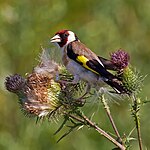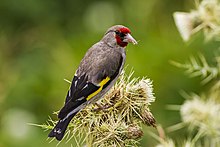Carduelis carduelis
The European goldfinch (Carduelis carduelis) or cardelina is a passerine bird belonging to the family of the finches. It is common in the western Palearctic, both in Europe and in North Africa and part of western Asia. In Spain there were around 2.8 million specimens in 2003. It is a granivorous bird, which feeds on sunflower seeds, wheat, some insects in the breeding season and especially the seeds of thistles. Since ancient times it has been bred in captivity due to its happy song, which is composed of trills that for some authors are similar to those of canaries. Two song codes are known at the competition level in Spain, the clean song and the free range song: of all its subspecies, the parva is the best gifted for singing, according to the vast majority of fans of the goldfinch song.
Description
It has a length of 11-13.5 cm, a wingspan of 21-25.5 cm, a weight of 14-19 g and a lifespan of seven to ten years (in captivity) The European goldfinch has a tricolor head with red face mask and black wings with yellow stripe.
Adult plumage is characterized by a very distinctive and conspicuous head, with a tricolor appearance, red facial mask, and black and white head pattern. The beak is typical and adapted to its diet. Conical, slender, sharp, pale in color. On the other hand, the body in the anterior part is whitish, bordered with ocher, while the posterior part is brownish. Wing very distinctive and conspicuous, both when perched and in flight. Black, with broad yellow wing stripe; white spots on the tip of the remiges of variable size, depending on the wear. The tail is black, notched, presenting rectrices with white tips.
Juvenile plumage has wings identical to adults, a uniform, mottled gray-brown head and body. It acquires the typical tricolor head pattern after the first partial molt in autumn. There are also intermediate plumages, which are indistinguishable from the adult except with the bird in hand, in which case, depending on the season and the molting cycle, it can be appreciated by remiges, wing coverts and rectrices.
The male and female are very similar, there is hardly any sexual dimorphism. With the bird in hand, or under very favorable observation conditions, the male shows a greater amount of red on the face, and generally darker nose feathers. Seasonal variation is non-existent, however, the progressive wear of the plumage reduces (and even eliminates) the white tips of remiges and rectrices, recovering them after the complete postbreeding moult.
Due to its tricolor head and conspicuous wing coloration, it is unmistakable with other species. Juveniles can lead to some confusion with females and immatures of other brownish finches, but only if the observation does not include the wing.
Molt cycles in juveniles are partial during the summer, while in adults the moult is also complete during the summer.
Distribution and habitat
The European goldfinch is distributed throughout the western Palearctic. It usually inhabits the edges of forests, groves, countryside, agricultural areas, parks, gardens, orchards, fruit groves and, in general, any herbaceous area, especially if there is an abundance of thistles (the species' favorite food); the key is minimal presence of trees. It breeds without difficulties in towns and cities.
It shows a predilection for hot environments, being less frequent to observe it as the altitude increases. It has been cited in the Swiss Alps at 2400 m s. no. m.; in the Catalan Pyrenees at 2000 m s. no. m., and in Sierra Nevada at 1850 m s. no. m..
Its predilection for ruderal plants, especially thistles and knapweeds, explains the high abundance of goldfinches in meadows and olive groves, habitats that provide trees to place the nest, and open land where they look for seeds.
In migration it is ubiquitous. In winter it also frequents wastelands and other open areas, even if they are not wooded.
Behavior
Playback
They usually breed twice a year. The first laying begins in mid-March or early April. The second laying is done after the first. Three clutches are rarely produced.
The clutch consists of five or six white eggs with fine reddish specks. Incubation lasts twelve to thirteen days, a period in which the male often feeds his mate in the nest. The nest, built almost exclusively by the female, is cup-shaped and is installed in the forks of the highest branches of some trees or shrubs.
The chicks, which are nidicolous, leave the nest and become independent from the parents after approximately fifteen days, reaching the final plumage after the autumn molt.
Migration
The European goldfinch behaves as a partially migratory. Northern populations migrate south; the winter quarters are located in the Mediterranean area. Southern populations can be sedentary, wandering, and even migratory to North Africa. Migration is by day, in more or less numerous groups. The migratory step is long; the bulk of the autumn migration occurs between September and November; that of spring occurs between February and May.
In regions like Spain it is considered a partial migrator, receiving wintering birds from Central Europe; the autumn passage occurs mainly in October and November, and the return takes place between March and May.
The Iberian individuals seem to abandon many of their breeding locations to move to North Africa, giving rise to a spectacular autumnal concentration in the Strait of Gibraltar, where it turns out to be the most abundant finches in migration, uniting with more northerly migrators; In this sense, very high densities have been cited to the south of Cádiz of the order of sixty-five birds per ten hectares.
Taxonomy and systematics
Subspecies
The species is divided into two major groups (carduelis and caniceps) and each group includes several races, their distribution overlapping in neighboring areas.
- Group C. c. carduelis.
- Carduelis carduelis balcanica. It is distributed in the southern centre of the former Yugoslavia, in southern Romania to the European side of Turkey and Crete. It is distinguished by being clearer in general.
- Carduelis carduelis brevirostris. Crimea and North Caucasus.
- Carduelis carduelis britannica. It is distributed in the United Kingdom, Ireland, West and North of France, the coastal areas of Belgium and the Netherlands. It is differentiated by presenting the darkest melanic areas and the clearest mask.
- Carduelis carduelis carduelis. Most of continental and Scandinavian Europe.
- Carduelis carduelis loudoni. It is distributed in northern Iran, and from Azerbaijan to eastern Turkey. It is distinguished by its shorter and more horny peak, the darkest and most extensive brown areas, and the mask of a darker red.
- Carduelis carduelis major or frigoris. It is distributed west of Siberia, east and south of the Yeniséi River, west of the Altái Massif, north of Kazakhstan and southeast of the European area of Russia. It is distinguished by its larger size, its purest white areas and its lightest brown tones.
- Carduelis carduelis niediecki. It is distributed by the Greek islands, Asia Minor, northern Iraq, the southwest of Iran, from north to south of the Caucasus, Egypt and Cyprus. It differs from being grayish and having a lighter brown. In the male the yellow color is better distinguished.
- Carduelis carduelis parva. It is distributed in the Macedonian Atlantic islands (Madeira, Canary Islands, Azores), Spain, south of France and northwest of Africa. It is differentiated by the greatest darkness of its brown areas and a slight brown infiltration in the white areas.
- Carduelis carduelis tschusii. It is distributed in Corsica, Sardinia, Elba and Sicily. It is differentiated by being smaller, with a smaller beak, and with a more diffuse and intense brown infiltration, staining clear areas.
- Group C. c. caniceps.
- Carduelis carduelis caniceps or "the Himalayan jilguero". It is distributed west of Pakistan and north of the Himalaya to Nepal.
- Carduelis carduelis paropanisi. It is distributed east of Iran, northeast of Afghanistan, and east to Uzbekistan, Tien Shan and Kazakhstan. It has the longest peak, the smallest mask and the grey tones with less black spots.
- Carduelis carduelis subulata. It is distributed by the centre and south of Siberia, the south centre of Altái and Mongolia to Lake Baikal. It is distinguished by its larger size, its lighter grey tones, and the presence of black spots on the sides.
The group caniceps has been proposed as a separate species.[who?]
Linnaeus classified the species as Fringilla carduelis.
Genetics
Genetically, the extant parent species of the common goldfinch (Carduelis carduelis) has been defined. It is Carduelis citrinella that probably gave rise to these Eurasian goldfinches in the Mediterranean islands, in the so-called Messinian Crisis, when the Mediterranean Sea was almost dry and was a set of salt pools of greater or less depth.
Arts
Antonio Vivaldi composed a flute concerto subtitled Il Gardellino (the Goldfinch) RV 428 (Op. 10 n° 3), in which the soloist repeatedly imitates his singing.
Contenido relacionado
Labyrinthulomycetes
Mosannona
Stenanthera








